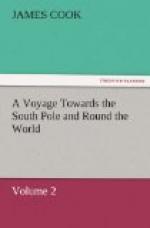Having now finished the survey of the whole archipelago, the season of the year made it necessary for me to return to the south, while I had yet some time left to explore any land I might meet with between this and New Zealand; where I intended to touch, that I might refresh my people, and recruit our stock of wood and water for another southern course. With this view, at five p.m. we tacked, and hauled to the southward with a fresh gale at S.E. At this time the N.W. point of the passage, or the S.W. point of the island Tierra del Espiritu Santo, the only remains of Quiros’s continent, bore N. 82 deg. W., distant three leagues. I named it Cape Lisburne, and its situation is in latitude 15 deg. 40’, longitude 165 deg. 59’ E.
The foregoing account of these islands, in the order in which we explored them, not being particular enough either as to situation or description, it may not be improper now to give a more accurate view of them, which will convey to the reader a better idea of the whole groupe.
The northern islands of this archipelago were first discovered by that great navigator Quiros in 1606; and, not without reason, were considered as part of the southern continent, which, at that time, and until very lately, was supposed to exist. They were next visited by M. de Bougainville, in 1768; who, besides landing on the Isle of Lepers, did no more than discover that the land was not connected, but composed of islands, which he called the Great Cyclades. But as, besides ascertaining the extent and situation of these islands, we added to them several new ones which were not known before, and explored the whole, I think we have obtained a right to name them; and shall in future distinguish them by the name of the New Hebrides. They are situated between the latitude of 14 deg. 29’ and 20 deg. 4’ S., and between 166 deg. 41’ and 170 deg. 21’ E. longitude, and extend an hundred and twenty-five leagues in the direction of N.N.W. 1/2 W. and S.S.E. 1/2 E.
The most northern island is that called by M. de Bougainville, Peak of the Etoile; it is situated, according to his account, in latitude, 14 deg. 29’, longitude 168 deg. 9’; and N. by W., eight leagues from Aurora.
The next island, which lies farthest north, is that of Tierra del Espiritu Santo. It is the most western and largest of all the Hebrides, being twenty-two leagues long, in the direction of N.N.W. 1/2 W. and S.S.E. 1/2 E., twelve in breadth, and sixty in circuit. We have obtained the true figure of this island very accurately. The land of it, especially the west side, is exceedingly high and mountainous; and, in many places the hills rise directly from the sea. Except the cliffs and beaches, every other part is covered with wood, or laid out in plantations. Besides the bay of St Philip and St Jago, the isles which lie along the south and east coast, cannot, in my opinion, fail of forming some good bays or harbours.




